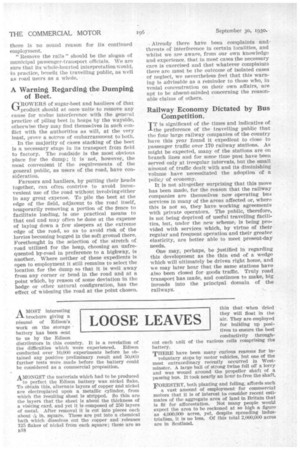A MOST interesting brochure giving a résumé of Edison's work on
Page 44

Page 45

If you've noticed an error in this article please click here to report it so we can fix it.
the storage battery has been -sent to us by the Edison distributors in this country. It is a revelation of the difficulties which were experienced. Edison conducted over 10,000 experiments before he obtained any positive preliminary result and 50,000 further tests were . made before the battery could be considered as a commercial proposition.
AMONGST the materials which had to be produced, to perfect the Edison battery was nickel flake. To obtain this, alternate layers of copper and nickel are electroplated upon a metallic cylinder, from which the resulting sheet is stripped. So thin are the layers that the sheet is about the thickness of a visiting card, and yet it is 'composedof 250 layers of metal. After removal it is cut into pieces each about -1,6in. square. These are put into a chemical bath which dissolves . out the copper and releases 125 flakes of nickel from each square ; these are so B18 thin that when dried they will float in the air. They are employed for building up positives to ensure the best conductivity throughout each unit of the various cells comprising the battery.
THERE have been many curious reasons for in voluntary stops by motor vehicles, but one a the most extraordinary recently occurred in Westminster. A large ball of strong twine fell off a lorry and was wound around the propeller shaft of a passing bus. It took nearly an hour to free the shaft FORESTRY, both planting and felling, affords such a vast amount of employment, for commercial motors that it is of interest to. consider recent estimates of the aggregate area of land in Britain that is fit for afforestation. Not many people would expect the area to be reckoned at so high a figure as 4,000,000 acres, yet, despite spreading industrialism, it is no less. Of this total 2,000,000 acres are in Scotland. ACCORDING to a paragraph in a daily paper, a bus was conveying a party of trippers near Mansfield, Saxony, when the crankshaft broke and smashed the bottom of the vehicle. Four of the passengers fell through the hole and were run over and killed by a motorcar.
We are anxious to know what the crankshaft was doing near the body and how it escaped from the crankcase. We can understand the possibility of siich an occurrence if it had been the cardan shaft that broke.
INTERESTING facts in relation to the use of gas fuel for airships were recently disclosed by Herr W. E. Doerr, designer of the Graf Zeppelin. Diesel engines, he said, were incomparably safer than petrol engines, but all types employing liquid fuel involved difficulties in maintaining the static equilibrium of the airship, for as the fuel was used the ship became lighter. The release of lifting gas in compensation is, of course, expensive, particularly when it is the precious helium.
More heat units, to the extent of 25 per cent., hard been obtained from Blau gas fuel than from a corresponding volume of liquid fuel, and as this has a specific gravity approximately equal to that of air, static equilibrium is not disturbed.
IT was revealed the other day at a meeting of the engineering section of the British Association that the effect of a side wind is more detrimental to the speed of a railway train than the effect of a head wind. This is aue to the strong tendency of a side wind to drive the train against one rail, materially increasing the friction of the wheel flanges on the one side. Motor vehicles do not suffer in this respect, but fleet operators, struggling for lower petrol consumption, would be surprised if they knew what a big factor is constituted by frontal wind resistance and the absence of rearward streamlining.




















































































































